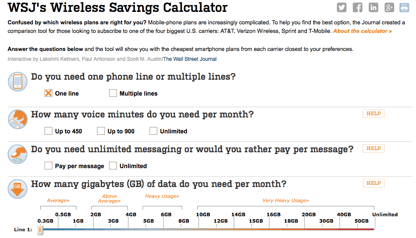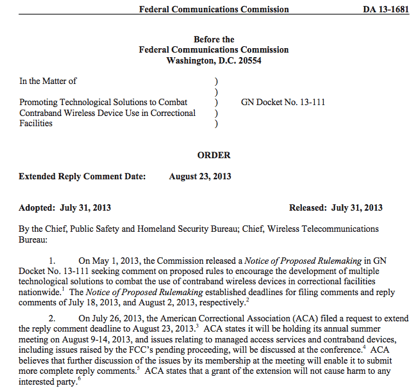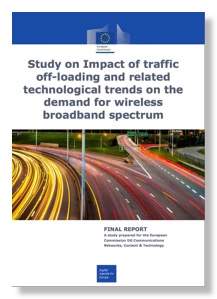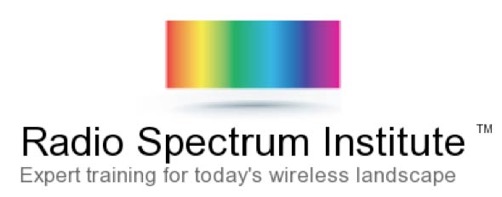MS-Supported Study: The case for permissive rule-based Dynamic Spectrum Access
Thanki compares a license-based access regime, in which a user will need to obtain a license through a regulatory award or market-based negotiation, to a rule-based access regime, "in which the satisfaction of certain conditions, such as limited transmit power levels, checking with an online database and/or payment of an access fee permits spectrum access."
Thanki does an interesting comparison of licensed and unlicensed systems that you rarely hear int he DC policy community:
The successes of the narrow licence-exempt bands demonstrate the power of rules- based access to spectrum. In twenty years of operation licence-exempt technologies now account for:
• The majority of innovation in wireless communications – licence-exempt connectivity is near ubiquitous in smartphones, tablets and PCs and is rapidly growing in a vast range of consumer and industrial goods. The licence-exempt bands are also home to a diverse range of open standards which act as a platform for further innovation.
• The majority of wireless devices – in 2013 fewer than 2.5 billion devices will be sold that incorporate licensed connectivity and nearly all of these will also feature complementary licence-exempt technologies. However, at least 2.5 billion devices will be sold that use licence-exempt communication technologies exclusively. This disparity is set to increase.
• The majority of Internet data traffic delivered to consumers – Wi-Fi carries 69% of the total traffic generated by smartphones and tablets and 57% of total traffic generated by PCs and laptops. Overall the volume of Internet data traffic delivered by licence-exempt Wi-Fi exceeds that of cabled connections and licensed mobile networks combined.
Thanki includes the following interesting table on unlicensed innovation vs. cellular innovation:

As a pioneer in creating today’s unlicensed spectrum environment, your blogger was certainly gratified by the closing words of the Thanki paper:
The relatively small ranges of frequencies opened up for non-discriminatory access have quickly become home to the majority of wireless innovation, the majority of wireless devices and the majority of wireless data traffic. This has surprised many in the spectrum management community who expected tradable exclusive licences to be the focus of investment, competition and innovation…
Granting exclusive-usage rights – over frequencies or frequencies at particular times or in particular places – is likely to hinder efficient usage and innovation. Instead, rule-based access has generated a virtuous cycle in which rapidly increasing usage enables and is enabled by advances in technology that allow ever more interleaved, interference-resistant communication. This is creating an unprecedented boom in wireless innovation as innovators are voting with their feet and adopting the licence- exempt bands which offer a multiplicity of low-cost, reliable and globally harmonised standards. Instead of pushing against this trend with schemes such as LSA, whose justification lies in economic theory rather than achievements in practice, better regulation would focus on expanding rules-based access, whose current achievements are only an inkling of its future potential, to further and more varied bands of spectrum.
But life is not really this simple and BOTH licensed and unlicensed approaches have complementary benefits. Unfortunately the cellular community’s love/have relationship with unlicensed tends to obscure the issue. Also the unlicensed community also sometimes overreacts, perhaps in response to the cellular community’s hype, with statements seeing unlicensed as a panacea.
The possible sale of Vodaphone’s share of VZW implies that VZW has a net worth in the order of $200B. This value does not just come from “monopoly rents”, rather VZW and other carriers have make significant investment in infrastructure. Cellular service may be ubiquitous in urban areas and on most major highways, but rural area cellular coverage still has limitations and always will in a privately operated system without universal service-like subsidies for areas where coverage makes little economic sense. (By contrast, Japan uses revenues derived from a $5/year spectrum use fee on all cell phones and all other transmitters to subsidize wireless infrastructure that is noneconomic. Such a policy in the US would be controversial and is not advocated here.)
This nationwide buildout of infrastructure would have been unlikely in a pure unlicensed spectrum model. However, despite the denials by the cellular industry today’s ubiquitous broadband would have been impossible without the licensed/unlicensed synergy that the cellular industry denies or minimizes as they constantly “diss” unlicensed.
Perhaps what we really need today is consensus building between the cellular community and the unlicensed community to get a better mutual understanding of each other’s roles and the mutually beneficial synergy between the two communities.
Nail Polish Remover & Cell Phones
Almost 2 years ago we wrote here, “Isn’t it odd that we are more concerned about over-the-counter sales of Sudafed and Plan B than we are about bagfuls of anonymous cellphones?” While cellphones are generally a product with positive social impact, the special case of anonymous “burner” phones is more questionable.
Sudafed and Plan B are also products with positive social impacts, but government regulators have placed modest limits on their sales in order to limit the negative potential for their use. (Plan B restrictions were basically thrown out in a later court case dealing with the details of FDA’s authority.)
Nail polish remover has a high acetone content and acetone is a key ingredient in making crystal meth. (The main ingredient of Sudafed is also used as a crystal meth ingredient.) So acetone and Sudafed are both “dual use products” with valid societal uses but a real potential for abuse. But so are burner cell phones which remain without any limits on their purchase and use.
For those who never watch TV, burner phones are the communications system of choice for gang members, drug dealers, and incarcerated criminals - not to mention adulterous spouses. Need one or several? Go into Walmart, Best Buy, etc. and buy a bagful or 2 for cash along with prepaid cards for extra time. (You need several to help cover your tracks. Throw them away after a week. That’s why they’re called “burners”.) Internet activation is needed, but heck, you just need the patience to enter fake names and addresses. The carriers don’t care!
Now CVS has decided that without a legal mandate it will take a reasonable step to limit nail polish sales to prevent its diversion to drug manufacture. A CVS spokesman has said,
"Because acetone is an ingredient used in the illegal manufacture of methamphetamine, we recently implemented a policy that a valid ID must be presented to purchase acetone-containing products such as nail polish remover. Our policy also limits the sale of these products in conjunction with other methamphetamine precursors and is based on various regulations requiring retailers to record sales of acetone. We are in the process of implementing this in all stores."
Here are several reports on this action in addition to the Fox DC Channel 5 video at the top:
So thanks to CVS for thinking about the implications of the products they sell. (However, they also sell burner phones and haven’t put any restriction on their sale.)
Maybe someday the cell phone industry will come to grips with the fact that totally unrestricted sale of burner phones is not really in the public interest. The proper solution is complicated by the fact that full documentation of all users may be difficult in some cases, e.g. battered spouses. But unless the industry and regulators start thinking about feasible practical controls the same national security pressure that has President Obama rationalizing the need for “metadata”, will likely result in more draconian action against unrestricted sale of burners.
WSJ Wireless Savings Calculator

My friend Rupert Murdoch’s minions at the Wall Street Journal have prepared the “wireless savings calculator” shown above that helps clear some of the mystery of what cellular pricing is really about.
Now I suppose that since Rupert has broadcast interests, the cellular community will just take this as bitterness about their spectrum expansion plans at the expense of broadcast interests. But the reality is that cellular pricing really is a mystery!
Of course the WSJ calculator doesn’t take into account the limited coverage of the carriers in rural areas and that fact that the smaller carriers really have a smaller footprint than the larger carriers. However, most customers probably stick to the places where all 4 carriers have coverage most of the time and for these users it may not matter much.
It also does not cover the new competitive area of replacing phones with new models.
Prison Cellphone Reply Comments Date Extended

In the above order from FCC, the reply comment date for the cellphones in prison rulemaking, Docket 13-111, has been extended to August 23, 2013.
There is a lot to comment on:
- AT&T objects to requiring a carrier to terminate service to a cell phone identified being in a prison saying it will only do so with an order from FCC or a court. (Perhaps FCC could set up a website and “rubber stamp” all requests from approved prison administrators and then forward the request to AT&T?)
- Boeing states that FCC could authorize managed access in cellular spectrum “without a spectrum lease agreement” and that “reliance on lease agreements to authorize managed access systems could create undesirable precedent” (Most other commenters just believe FCC should simplify leasing and, except for MSS comments, do not suggest that leasing should be mandatory or should be on reasonable terms.)
- CTIA believes that mandatory service termination of cell phones operating in prisons can not be authorized unless FCC “adopt(s) clear, standardized requirements that apply to all cell detection systems” - a clear multiyear delay unless CTIA wants to be helpful -- as opposed to be obstructive.
- Verizon thinks service termination requests should require a court order. Heck, AT&T is more open minded and is willing to consider a request from FCC! (Sprint & T-Mo have not commented as yet.)
- NTCH, Inc. (a regional CMRS carrier that offers service under the trade name CLEAR TALK) says FCC “should declare the confines of prisons, including surrounding lands owned or controlled by the prison system, to be ‘quiet zones’ akin to the Commission's treatment of radio astronomy and other research facilities designated by the Commission…A corrections department could only declare a site a quiet zone in connection with its designation of one or more entities that would bear the expense and take the responsibility of preventing unauthorized transmissions in the prison confines and would also be in a position to offer service over authorized frequencies in the prison area…Once designated as the Prison Service Provider, the Provider would be authorized to prevent or create interference to any unauthorized transmissions from within the prison confines (including the buffer zone described below) because no such transmissions would be lawful under the terms of the licenses pursuant to which the offending cell phones would normally be operating…This plan relies on well-known quiet zone protection principles but extends not just to astronomical observations but to measures which directly protect human health and safety. The modest diminution in rights which the cellular carriers would experience under this plan is far outweighed by the benefits to the public which would result.”
- All the comments can be found at http://apps.fcc.gov/ecfs/proceeding/view?name=13-111.
vox populi, vox dei
Europe loves Wi-Fi: new EU study recommends more spectrum should be made available
(The primary author of the study is former FCC staffer J. Scott Marcus, now with Germany’s WIK Consult, who is not related to your blogger although we were friendly when we both worked down the hall from each other and while we both lived in Europe.)
It appears that the cellular establishment was behind the ill fated Section 104 of The Spectrum Innovation Act of 2011 that would have required an ill conceived unlicensed auction before FCC could create any additional unlicensed spectrum, even in ISM bands or above 100 GHz! However, the cellular establishment covered its tracks very well because no one ever spoke in public in favor of this odd provision. But since this provision appeared in a House committee staff memo written by a former CTIA staffer, it is a likely guess that CTIA was somehow behind it.
Here is the report summary from the EU website:
How is traffic off-loading evolving over time, both in terms of technical and of market developments, and how does this evolution influence the need for spectrum? It is widely recognized that traffic on the macro cellular network is growing rapidly, largely as a result of impressive take-up of smartphones and tablets. The surprising and little recognized reality is that, according to credible data captured from a range of sources, the visible growth in macro cellular mobile network traffic appears to be only the tip of a much larger iceberg. The volume of traffic that is already being off-loaded, chiefly to Wi-Fi in the home, already exceeds that of the mobile network, and can be expected to grow even faster as well. This is largely a result of the considerable effort that equipment vendors and standards bodies have invested in developing both Wi-Fi and cellular standards to improve interworking between the two and to optimise use of the available spectrum. Traffic off-load generates surprisingly large socio-economic benefits by virtue of the cost that MNOs have saved, or can be expected to save, by building a smaller network thanks to data traffic off-load. Relatively little action is needed at European level; however, a few interventions should be considered in order to ensure that the momentum is maintained. Among these are (1) seeking to make spectrum from 5150 MHz to 5925 MHz available globally for Wi Fi; (2) continue seeking to make 2.6 GHz and 3.5 GHz fully available for mobile use; (3) consulting on future licensing options for 3.5 GHz and other potential new licensed mobile frequency bands; and (4) various measures to reduce administrative burden on the deployment of public off-load services and networks.
Now the spectrum actions here are not really different from what the FCC is trying to do. But FCC seems too intimidated by the cellular establishment and their endless appetite for new spectrum to talk very visibly about this topic. However, snooping around the FCC website we did find this statement in an FCC blog in 2011 by John Leibovitz & Robert Alderfer:
Importantly, the (Cisco) report accounts for some offsetting effects, most notably the use of WiFi and femtocell networks to “offload” capacity from the mobile network to a fixed broadband connection. Cisco estimates that about 21% of traffic from smartphones and tablets was offloaded to WiFi or femtocells in 2010 and that this proportion will increase to 30% by 2015. This finding demonstrates the vital importance of unlicensed spectrum in helping address our nation’s wireless capacity needs. Still, overall traffic growth is likely to outpace offloading, according to Cisco’s forecast.
Also in 2011 Chmn. Genachowski said “Traffic offloading to WiFi helps reduce congestion that could otherwise impair the flow of data on commercial networks. WiFi and other innovations based on unlicensed spectrum have contributed hundreds of billions of dollars to our economy, and offer tremendous potential to foster economic growth and job creation.”

(Graphic from EU website)






![Validate my RSS feed [Valid RSS]](valid-rss-rogers.png)

